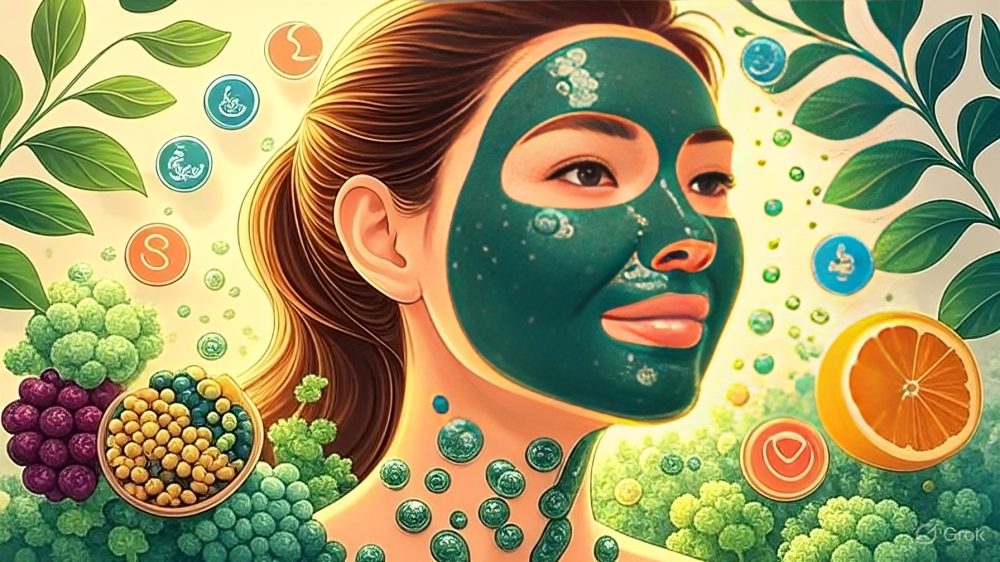In the ever-evolving world of skincare, one ingredient has been making waves across beauty counters and health food stores alike: spirulina. This vibrant blue-green algae, once relegated to health smoothies and supplement bottles, is now being hailed as a revolutionary skincare superfood. But is spirulina truly the skin-transforming miracle it’s claimed to be, or is this just another beauty trend destined to fade? Let’s dive deep into the science behind spirulina’s skin benefits and separate fact from fiction.
What is Spirulina?
Spirulina is a type of blue-green microalgae (technically a cyanobacteria) that has been consumed for centuries, particularly by ancient civilizations in Africa and Mexico. This microscopic organism thrives in alkaline lakes and has earned its superfood status due to its exceptional nutritional density.
What makes spirulina particularly fascinating is its unique composition. Unlike many plant-based ingredients, spirulina contains a complete protein profile with all essential amino acids. It’s also packed with:
- Phycocyanin: The blue pigment responsible for spirulina’s distinctive color and many of its therapeutic properties
- Vitamins A, C, E, and B12: Essential for skin health and cellular repair
- Beta-carotene: A powerful antioxidant that converts to vitamin A
- Omega-3 and omega-6 fatty acids: Crucial for maintaining skin barrier function
- Minerals: Including iron, manganese, and zinc
- Chlorophyll: Known for its detoxifying properties
Why is Spirulina Blue?
The striking blue-green color of spirulina comes from phycocyanin, a unique protein-pigment complex that’s exclusive to blue-green algae. This compound is not just responsible for spirulina’s appearance—it’s also the powerhouse behind many of its skin benefits, acting as a potent antioxidant and anti-inflammatory agent.
The Science Behind Spirulina’s Skin Benefits
Phycocyanin: The Star Compound
Phycocyanin is arguably spirulina’s most valuable component for skin health. Research has shown that this blue pigment possesses remarkable properties:
- Antioxidant activity: Studies indicate that phycocyanin can neutralize free radicals more effectively than many conventional antioxidants
- Anti-inflammatory effects: It helps reduce skin inflammation and redness
- UV protection: Some research suggests phycocyanin may offer mild photoprotective benefits
- Skin tone evening: Regular use may help reduce hyperpigmentation and dark spots
Collagen Production and Anti-Aging Properties
One of the most compelling aspects of spirulina for skincare is its potential to support collagen synthesis. A 2018 study published in the Journal of Cosmetic Dermatology found that spirulina extract could stimulate dermal fibroblast cells, which are responsible for producing collagen and elastin.
The mechanism works through several pathways:
- Amino acid supply: Spirulina provides the building blocks necessary for collagen formation
- Antioxidant protection: Prevents collagen breakdown from oxidative stress
- Elastase inhibition: May help reduce the activity of enzymes that break down skin elasticity
Antimicrobial and Anti-Fungal Properties
Spirulina’s antimicrobial properties make it particularly beneficial for acne-prone and problematic skin. Research has demonstrated its effectiveness against various bacteria and fungi that can contribute to skin issues:
- Propionibacterium acnes: The bacteria primarily responsible for acne breakouts
- Candida species: Fungal organisms that can cause skin irritation
- Staphylococcus epidermidis: A common skin bacteria that can become problematic
Spirulina Benefits for Specific Skin Conditions
Acne and Blemish Control
For those struggling with acne, spirulina offers a multi-pronged approach:
- Reduces inflammation: The anti-inflammatory properties help calm existing breakouts
- Controls bacterial growth: Antimicrobial effects target acne-causing bacteria
- Regulates oil production: May help balance sebum production
- Promotes healing: Accelerates the recovery process for blemished skin
Anti-Aging and Wrinkle Prevention
Spirulina’s anti-aging benefits extend beyond simple antioxidant protection:
- Stimulates cellular renewal: Encourages faster skin cell turnover
- Improves skin elasticity: Supports collagen and elastin production
- Reduces fine lines: Regular use may help minimize the appearance of wrinkles
- Enhances skin firmness: Contributes to overall skin tightening effects
Hyperpigmentation and Dark Spots
The combination of antioxidants and phycocyanin in spirulina can help address uneven skin tone:
- Inhibits melanin production: May help prevent new dark spots from forming
- Promotes cell turnover: Helps fade existing hyperpigmentation
- Provides photoprotection: Offers mild protection against UV-induced damage
Eczema and Psoriasis Support
While more research is needed, preliminary studies suggest spirulina may benefit inflammatory skin conditions:
- Reduces inflammation: Anti-inflammatory compounds help calm irritated skin
- Supports barrier function: Essential fatty acids help maintain skin integrity
- Provides nutrients: Delivers vitamins and minerals essential for skin repair
Different Forms of Spirulina for Skincare
Understanding the various forms of spirulina available can help you choose the most effective option for your skin:
Spirulina Powder
- Pros: Versatile, cost-effective, easy to incorporate into DIY treatments
- Cons: Can be messy, may have a strong taste/smell
- Best for: Face masks, spot treatments, mixing with other ingredients
Spirulina Extract
- Pros: More concentrated, easier to formulate, less odor
- Cons: More expensive, may be less readily available
- Best for: Commercial skincare products, serums, targeted treatments
Spirulina Supplements
- Pros: Convenient, standardized dosing, systemic benefits
- Cons: Indirect skin benefits, slower results
- Best for: Overall health support, complementing topical treatments
DIY Spirulina Skincare Recipes
Hydrating Spirulina Face Mask
Ingredients:
- 1 teaspoon spirulina powder
- 2 tablespoons plain Greek yogurt
- 1 teaspoon honey
- 1/2 teaspoon aloe vera gel
Instructions:
- Mix all ingredients until you achieve a smooth paste
- Apply to clean skin, avoiding the eye area
- Leave on for 15-20 minutes
- Rinse with lukewarm water and pat dry
Anti-Acne Spirulina Spot Treatment
Ingredients:
- 1/2 teaspoon spirulina powder
- 1 teaspoon clay (bentonite or kaolin)
- 1-2 drops tea tree oil
- Water or rose water to mix
Instructions:
- Combine dry ingredients
- Add liquid gradually until you form a thick paste
- Apply directly to blemishes
- Leave on for 10-15 minutes or until dry
- Rinse gently with water
Brightening Spirulina Cleanser
Ingredients:
- 1/4 teaspoon spirulina powder
- 1 tablespoon gentle cleanser
- 1/2 teaspoon lemon juice (optional, for oily skin)
Instructions:
- Mix spirulina powder with your regular cleanser
- Massage gently onto damp skin for 1-2 minutes
- Rinse thoroughly with water
- Use 2-3 times per week
Spirulina vs. Chlorella: Which is Better for Skin?
While both spirulina and chlorella are nutrient-dense algae, they offer different benefits for skin health:
Spirulina Advantages:
- Higher phycocyanin content
- Better studied for skin applications
- More potent anti-inflammatory effects
- Easier to incorporate into skincare formulations
Chlorella Advantages:
- Higher chlorophyll content
- Superior detoxification properties
- More vitamin C
- Better for overall cellular health
Verdict: For targeted skin benefits, spirulina generally takes the lead due to its phycocyanin content and established research in dermatological applications.
Optimal Dosage and Frequency Guidelines
Topical Application:
- Face masks: 1-2 times per week
- Spot treatments: As needed, up to daily
- Cleansers: 2-3 times per week
- Concentration: 0.5-2% in commercial products
Oral Supplementation:
- Daily dose: 1-3 grams per day
- Timing: With meals to improve absorption
- Duration: Consistent use for 8-12 weeks to see skin benefits
Safety Considerations and Potential Side Effects
While spirulina is generally considered safe, there are important considerations:
Who Should Avoid Spirulina:
- Individuals with phenylketonuria (PKU)
- Those with autoimmune conditions (consult healthcare provider)
- People allergic to seafood or iodine
- Pregnant or breastfeeding women (without medical supervision)
Potential Side Effects:
- Topical: Rare allergic reactions, temporary blue-green staining
- Oral: Digestive upset, headaches (usually mild and temporary)
- Quality concerns: Contamination with heavy metals or toxins in low-quality products
Safety Tips:
- Always patch test new topical applications
- Choose reputable, third-party tested products
- Start with lower concentrations and frequencies
- Discontinue use if irritation occurs
Clinical Research and Future Prospects
While the current research on spirulina for skin health is promising, most studies have been conducted in vitro (test tube) or on animals. The field would benefit from more robust human clinical trials to fully establish spirulina’s efficacy for various skin conditions.
Recent studies have shown encouraging results:
- A 2020 study found that topical spirulina extract improved skin hydration by 16% after 4 weeks of use
- Research published in 2019 demonstrated significant anti-inflammatory effects in human skin cell cultures
- A 2021 pilot study suggested that oral spirulina supplementation could improve overall skin appearance in healthy adults
Long-Term Effects and Sustainability of Benefits
One advantage of spirulina over synthetic skincare ingredients is its potential for sustained benefits. Because spirulina works by:
- Supporting natural cellular processes
- Providing ongoing antioxidant protection
- Supplying essential nutrients for skin health
Regular use may lead to cumulative improvements rather than temporary effects that disappear when use is discontinued.
Interactions with Other Skincare Ingredients
Spirulina generally plays well with other skincare ingredients, but some combinations are particularly synergistic:
Beneficial Combinations:
- Vitamin C: Enhanced antioxidant protection
- Hyaluronic acid: Improved hydration and delivery
- Niacinamide: Complementary anti-inflammatory effects
- Peptides: Synergistic anti-aging benefits
Combinations to Approach Cautiously:
- Strong acids (glycolic, salicylic): May reduce spirulina’s effectiveness
- Retinoids: Start slowly to avoid over-stimulation
- Benzoyl peroxide: May oxidize spirulina compounds
The Verdict: Superfood or Super Skin Care?
Based on the available evidence, spirulina appears to be both a legitimate superfood and a promising skincare ingredient. Its unique combination of phycocyanin, antioxidants, amino acids, and vitamins provides multiple pathways for skin health improvement.
However, it’s important to maintain realistic expectations. While spirulina can be a valuable addition to your skincare routine, it’s not a miracle cure. The best results come from:
- Consistent use over time
- Combining topical and oral applications
- Using high-quality, properly sourced products
- Maintaining a comprehensive skincare routine
Frequently Asked Questions
Q: How long does it take to see results from spirulina skincare?
A: Most people notice initial improvements in skin texture and hydration within 2-4 weeks of consistent use. More significant changes in skin tone, fine lines, and overall appearance typically become apparent after 8-12 weeks.
Q: Can spirulina cause skin purging?
A: Spirulina is unlikely to cause traditional “purging” like retinoids or acids. However, some people may experience temporary breakouts as their skin adjusts to new ingredients. This typically resolves within 1-2 weeks.
Q: Is spirulina suitable for sensitive skin?
A: Spirulina is generally well-tolerated by sensitive skin due to its anti-inflammatory properties. However, always patch test first and start with lower concentrations to ensure compatibility.
Q: Can I use spirulina skincare products during pregnancy?
A: Topical spirulina products are generally considered safe during pregnancy, but it’s always best to consult with your healthcare provider before introducing new skincare ingredients.
Q: Does spirulina stain the skin?
A: High-quality spirulina products should not permanently stain the skin. However, temporary blue-green discoloration may occur immediately after application, which should wash off completely.
Conclusion
Spirulina represents a fascinating intersection of nutrition and skincare science. While more human clinical trials are needed to fully validate all claimed benefits, the existing research and centuries of traditional use suggest that this blue-green algae deserves its place in the modern skincare arsenal.
Whether you choose to incorporate spirulina through DIY masks, commercial skincare products, or oral supplements, this nutrient-dense superfood offers a natural, science-backed approach to healthier skin. As with any skincare ingredient, consistency and quality are key to achieving the best results.
Ready to harness the power of this aquatic superfood for your skin? Start with a patch test, choose high-quality products, and give spirulina the time it needs to work its magic. Your skin—and your overall health—may thank you for making this ancient superfood a part of your modern skincare routine.



